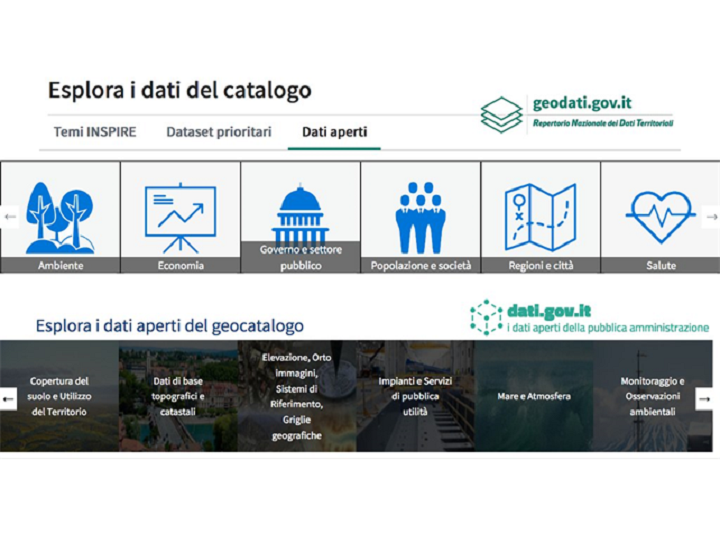Italy, discoverability in practice
This article was written by Gabriele Ciasullo, Giovanna Scaglione and Antonio Rotundo from AgID, in charge of managing the Italian National Open Data Portal (https://dati.gov.it) and National Catalogue for Spatial Data (https://geodati.gov.it)

Data discoverability is one of the main tasks, next to availability and interoperability, that public policy makers and implementers should take into due consideration in order to foster access, use and re-use of public sector information (PSI), particularly in case of open data.
Users shall be enabled to easily search and find data they need for the most different purposes. That is clearly highlighted in the introduction statements of the INSPIRE Directive, where we can read that “The loss of time and resources in searching for existing (spatial) data or establishing whether they may be used for a particular purpose is a key obstacle to the full exploitation of the data available”.
Metadata and data portals/catalogues are essential assets to enable that data discoverability. In Italy, AgID (Agency for Digital Italy) is in charge of managing the National Open Data Portal (dati.gov.it) and the National Catalogue for Spatial Data (RNDT - geodati.gov.it). These catalogues are the core components of an overall PSI infrastructure to be intended as the knowledge base of all PSI, implemented by the actions defined in the Three-Year Plan for ICT in the Public Administration 2019-2021.
Recently the new version of both catalogues was released with important new features aimed at:
- Further improving the user experience in the search, access and use of public data; and
- Facilitating the use of the functionalities for the documentation of data and services by the administrations.
Some examples of these new features are:
- harvesting by dati.gov.it of data sources consistent with the national metadata profile DCAT-AP_IT;
- dataset search for each data provider, as well as for catalogue, under the new section “Administrations” in dati.gov.it; and
- the pre-defined view for “priority datasets” in geodati.gov.it as defined under the INSPIRE context.
The main aim of these activities is to make public data available to an ever wider and diversified audience. In this regard, the most significant action, defined in the three-year plan mentioned above, has concerned the interoperable integration and coordination of the two catalogues through the implementation of GeoDCAT-AP to ensure aligned, up-to-date and not conflicting descriptions of spatial data even available as open data. Thanks to that, open spatial data documented in the RNDT are also discoverable in the open data portal, without any other burden for data providers.
Linked to that, specific pre-defined views were implemented in both catalogues in order to immediately identify:
- open data in geodati.gov.it, using DCAT-AP themes as search criteria; and
- open spatial data coming from RNDT in dati.gov.it, using the INSPIRE themes as search criteria.
The classification of open spatial data against the DCAT-AP themes is based on the alignments between the controlled vocabularies used in ISO 19115 / INSPIRE metadata and those used in DCAT-AP defined under the ISA2 programme. Other alignments needed for the implementation of GeoDCAT-AP and the coordination of the two catalogues are being published in the registry managed by AgID too (an example of a cross-map register is available at this URL).
Finally, in order to address a wider audience, including non-GI experts, spatial data documented in RNDT is also available through the web search engines, specifically Google Dataset Search. A relevant current example on how that discoverability, outlined in this blog post, concretely works is the COVID-19 open data published by the Italian Department for Civil Protection, including national trends, provinces and regions data and areas, under the license CC-BY 4.0.
Metadata for those datasets were published in RNDT as spatial data (e.g. see metadata for the dataset of zones at national level for containing COVID-19 contagion) and, consequently, those datasets are also made discoverable:
- in dati.gov.it as open data;
- in the data.europa.eu, as both dati.gov.it and geodati.gov.it are harvested;
- in the INSPIRE Geoportal, as geodati.gov.it is harvested;
- in Google Dataset Search.
In summary, Open Data are available in an ‘universal’ way, regardless the search tool used by the users. Additional features are being implemented in both catalogues and will be presented in a future blog post.
